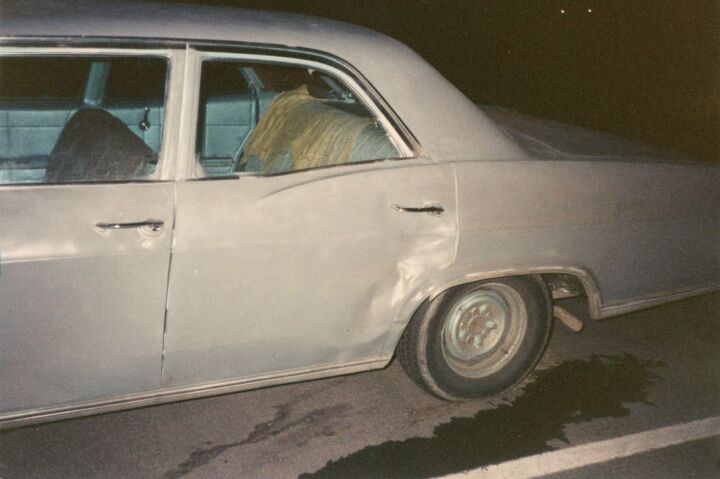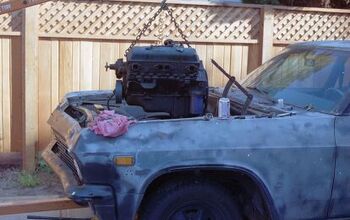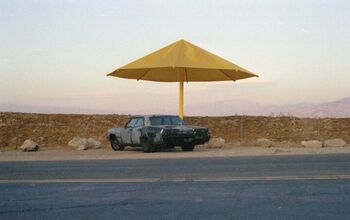1965 Impala Hell Project Part 1: So It Begins

As I explained in the introduction to this series last week, I’m finally tackling the story of the most significant car I’ve ever owned. This ’65 Impala went through ten years, 100,000 miles, and many conceptual shifts during its time with me, but it all started out as my attempt to make an art car that wasn’t A) lame and B) contemptuous of the idea of the car itself.
Let’s face it: most art cars are attempts by the artist to spit on the canvas they’re using, to subvert the paradigm represented by the evil chariot of sprawl, pollution, and oppression, blah blah blah. Even if you agree with that view of the automobile, art cars tend to be no more than poorly— if earnestly— executed hippie doodles, the kind of thing that requires only time and a willingness to piss off the neighbors.
Which isn’t to say that all art cars suck; the amazing Sashimi Tabernacle Choir, for example, makes up for all 10,000 Tauruses with plastic action figures hot-glued all over their flanks.
Back in the pre-Internet Dark Ages of the late 1980s, however, the only art cars I’d seen were pretty weak. At that time, I was an art/English major living in a middle-class shantytown at an image-obsessed Orange County (California) university. Obsessed with the work of UCI product Chris Burden and under the influence of various crypto-nihilo-miscreants ranging from Laurie Anderson to Survival Research Laboratories, I developed the delusion that I might manage to make a living creating weird art. My band, Murilee Arraiac (yes, that’s the source of my pseudonymous first name; more on where the Murilee Arraiac/Martin name came from later, if anyone cares), a sort of cut-rate Negativland/ Throbbing Gristle/ Psychic TV-style difficult/noise outfit, played gigs in which my “instrument” was a police scanner feeding three OD-1 overdrive pedals and a Maestro “Wow-Wow” pedal.
I made Murilee Arraiac music videos with Super 8 cameras and tube-based thrift-store video cameras.
Meanwhile, I was abusing my privileges at the Art Department’s darkroom and metal shop, plowing through vast quantities of photo chemicals and welding supplies. Here’s a shot I made for a series of no-commercial-potential Christmas cards, entitled “Chicom Junky Santa Cookin’ Up Skag For The Holidays.” Note the cotton-ball beard.
Of course, UCI being a performance art powerhouse, I put together some performance/installation pieces. Here’s a 1988 piece entitled “Our Friend The Carburetor.” Clearly, I was a decade or two too early to be an “interdisciplinary multimedia artist,” but I still felt that I was going somewhere with my work. What I really needed, I decided in late 1989, was a piece based on a car that I’d buy and modify entirely for the sake of my art. Dropping in on a particularly bewildered art professor, I convinced him to sign off on some sort of “Independent Studies” sculpture piece, essentially granting me graduation credits for doing… something with a car. The question at that point was: what kind of car? I had a $400 tax refund to work with, plus a bunch of random Ford parts left over from the ’68 Mercury Cyclone and ’69 Torino fastback I’d owned in the recent past.
My daily driver at the time was a British Racing Green chrome-bumper MGB-GT, which I wouldn’t have hacked up even if it had been appropriate for the project I had in mind (in spite of being underpowered, ill-handling, and unreliable). No, what I wanted was a car that would let me riff on what I considered to be three very important American negative automotive archetypes:
Quite a dilemma, and no single car would be perfect on all three fronts. I scanned The Recycler classifieds every week, and finally came across this ad. The 1965 full-sized Chevrolet fit each of my three archetypes to a certain extent, junkyard parts (at the time) were ridiculously easy to find, and I could deflect criticism that I’d be “ruining” a “classic” by pointing out that the ’65 big Chevy had the highest single-year production figure for any vehicle ever made by Detroit: 1,463,200 Bel Airs, Biscaynes, and Impalas that year. I went to the bank, got 30 $10 bills (makes a fatter stack than $20 bills), and headed over to Surf City USA.
The car was located in a sketchy skinhead-infested neighborhood of HB, and the seller was a woman who alternated screaming at her many children and screaming at her many dogs as we negotiated. She kept pointing out that the high beams and low beams worked, to which I’d respond by pointing out that the 300,000-mile 283 smoked like crazy, the interior smelled like a mixture of boiling piss and burning horsehair, the tires were a mix of bald bias-plys and bald radials, and the oil-pressure light flickered ominously at idle. My plan was to drop in a junkyard 350 as soon as possible, but I still wanted to get a few miles out of the 283. The car had started life clad in Tahitian Turquoise paint, but a previous owner had applied a thick coat of some sort of industrial gloss-gray paint on it.
Flashing my fat roll of Hamiltons and standing firm on various lowball offers eventually paid off, and the car was mine for the sum of 150 American dollars. Roaring down the 405, with the smell of burning 30-weight in my nostrils, I felt excited but intimidated by the task before me.
Getting back to Irvine Meadows West, the UCI trailer park that was bulldozed by minions of The Irvine Company back in 2005, I admired the 283/Powerglide combo. The 2-barrel 283 had bad rings and valve guides, among other super-tired-engine woes, but it started readily and still offered decent power. The Powerglide worked fine, and would no doubt keep working until the day the sun went supernova, as is traditional for the venerable two-speed slushbox.
The interior needed plenty of work to fit with the triple-archetype concept behind my project. Actually, it needed plenty of work just to keep me and my passengers safe from scabies, ringworm, and lead poisoning; the front bench seat was stuffed with several layers of wet newspapers and dog-juice-soaked blankets, and the back seat wasn’t much better. The weatherstripping had long since dissolved into black powder, thanks to decades of high-sulfur-and-ozone Southern California air and blazing sunlight, so rainy California winters made for soaked carpets and excellent fungal breeding opportunities. Fortunately, self-service junkyards in 1990 were bursting with big GM sedans, so I’d be able to mix-and-match interior components while engine shopping. Next up: Part Two: The Modifications Begin.

Murilee Martin is the pen name of Phil Greden, a writer who has lived in Minnesota, California, Georgia and (now) Colorado. He has toiled at copywriting, technical writing, junkmail writing, fiction writing and now automotive writing. He has owned many terrible vehicles and some good ones. He spends a great deal of time in self-service junkyards. These days, he writes for publications including Autoweek, Autoblog, Hagerty, The Truth About Cars and Capital One.
More by Murilee Martin
Latest Car Reviews
Read moreLatest Product Reviews
Read moreRecent Comments
- Drnoose Tim, perhaps you should prepare for a conversation like that BEFORE you go on. The reality is, range and charging is everything, and you know that. Better luck next time!
- Buickman burn that oil!
- Jkross22 Meant to ask.... what's the best oil to use in a popcorn popper? I've been wanting to try peanut oil, but can't find anything smaller than the huge container at smart n final.
- Ajla A union fight? How retro 😎
- Analoggrotto Finally, some real entertainment: the Communists versus the MAGAs. FIGHT!














































Comments
Join the conversation
@ John. Ford and chrysler V8's still used steel timing gears in the 60's. It was not uncommon in those days for the oil light to flicker at idle. It could have been from a number of factors, like bearing or oil pump clearances, type and weight of oil used, low idle speed or even an over sensitive oil pressure switch. @Murilee, while I agree that the 283 was a pretty long wearing engine by small block chevy standards, especially compared to the later 305 and 350, I highly doubt that 283 had 300k on it.
Wow I already can't wait to see the finished project!